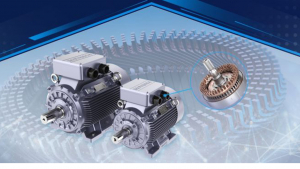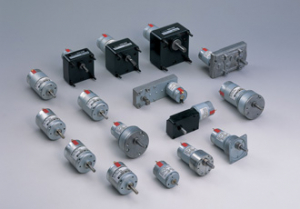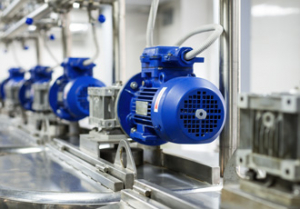BALDOR EXTENDS NOVEL DIRECT-DRIVE SOLUTION FOR COOLING TOWER FANS TO HIGH POWER RATINGS REQUIRED FOR POWER GENERATION AND LARGE PROCESSING PLANTS
12th January 2011
Source:
Baldor UK Ltd
* approach eliminates gearbox and delivers optimised variable fan speed control
Bristol, UK, December 8, 2010 --- Baldor has extended the range of its novel direct drive technology for controlling cooling tower fans to higher power ratings that can handle very large applications in power generating plants and heavy processing industries.
First introduced in 2009, Baldor's direct drive solution for cooling tower fans has delivered a radically more efficient solution to cooling tower fan applications. It eliminates the gearbox and right-angled coupling of conventional drive solutions to save energy, improve reliability, and run much quieter. The elimination of gearbox losses is aided by the use of a novel permanent magnet based motor that increases energy efficiency dramatically. This construction reduces the size of the motor substantially, allowing it to sit underneath the fan in the space currently required for the gearbox element of a conventional power transmission system.
The new technology is already changing the way that cooling tower fans for commercial buildings are constructed. The latest product additions now extend the power rating of the motors to delivers maximum torques of up to 13,500 Nm. In total there are now 26 choices of ratings available, spanning a drive power range from 7.5 kW at 500 RPM base speed to 187 kW at 130 RPM base speed, allowing optimum choices to be made for a very wide range of cooling applications from building HVAC (heating, ventilating, and air conditioning) systems to the large sizes of cooling tower fans used in many heavy-duty processing plants and power generating stations.
Air cooling towers are commonly used as part of HVAC systems. In these systems, large fans pull air over a water soaked media to cool the water before it is returned to the chiller unit.
The most common technique for driving such fans has been a standard AC induction motor, connected to the fan via a drive shaft and disc coupling arrangement into a right angle gearbox - which reduces the motor's speed to the range required for fan circulation. Such arrangements are prone to a number of drawbacks: the gearbox runs at high speed and requires regular inspection and maintenance of the lubrication and seals; misalignments in the power transmission system can cause vibration, wear and noise; and the complex power transmission system introduces significant energy losses.
Baldor's unique new solution, the VS1 Cooling Tower Drive, provides a direct slow-speed drive for the fans combined with variable speed control that is optimised for the building cooling application. By eliminating the drive shaft and gearbox the solution minimises moving parts, greatly improving reliability and power efficiency - as well as reducing system bill-of-materials.
The unique interior permanent magnet synchronous motor design uses energy efficient technology that, in combination with the elimination of the gearbox and drive train transmission losses, results in a more efficient system compared to conventional fixed speed designs. Additional significant energy savings can be gained by being able to operate the fan at reduced speeds during non-peak load conditions. The direct drive also greatly reduces noise and eliminates the issue of cooling tower water becoming contaminated from leaky gearboxes.
The direct drive fan motor is controlled by a Baldor VS1 drive with a specially developed speed control algorithm. Variable speed control of fans can save an enormous amount of energy compared with older fixed speed solutions. Baldor's algorithm provides sensor-less control of the permanent magnet motor that is optimised to manage the large inertia of the fan, with a low starting current requirement.
The motor is a synchronous type from Baldor's RPM family, based on permanent magnets. Thanks to dramatic improvements in the magnetic and thermal properties of permanent magnet materials in recent years this technology now represents a viable alternative to conventional AC induction motors and delivers a significant energy efficiency advantages - even compared with the latest premium-efficiency types of motor. Laminated frame technology is used in the design, eliminating the conventional cast iron outer frame of large AC motors and allowing more room for active (torque producing) magnetic material. This produces a highly torque-dense motor, allowing Baldor to also offer the technology to the cooling tower retrofit market, for installation in the same space currently used for the gearbox. The motor will provide continuous constant torque over its entire range from zero up to base speed, and employs optimum pole construction to maximise both efficiency and power factor.
A high degree of protection is an important factor for this application, as the operating environment is extremely humid. An epoxy compound insulation applied via vacuum pressure impregnation - a technique derived from a system originally developed for Navy applications - is used for the stator windings. The drive end of the motor is also protected by a metallic, non-contacting, no-wearing, Inpro labyrinth shaft seal in combination with a slinger cover to prevent the ingress of moisture and contamination into the motor.
Before launch, Baldor's new product was trialled and compared with a conventional cooling tower fan drive system, at a university building with identical twin cooling towers housing 5.5 metre (18 feet) fans. One tower was left as originally constructed. The other was retrofitted with the new Baldor permanent magnet motor and variable speed drive. Independently verified power measurements showed a decrease in input power of approximately 13% for the direct drive arrangement when running at full load - yielding very significant electricity cost savings.
The drive system is now available in nominal power ratings from 7.5 to 187 kW (10 - 250 HP), 500 to 130 RPM base speed, to drive cooling fans from typically 2.1 to 8 metres (7 - 26 feet) in diameter.
The motor flange footprint is designed to interchange with gear reducers that are widely used in today's global cooling tower market. Adding a foot mounting adapter plate is a simple means of fitting the motor in other gearbox footprints.
The new technology is already changing the way that cooling tower fans for commercial buildings are constructed. The latest product additions now extend the power rating of the motors to delivers maximum torques of up to 13,500 Nm. In total there are now 26 choices of ratings available, spanning a drive power range from 7.5 kW at 500 RPM base speed to 187 kW at 130 RPM base speed, allowing optimum choices to be made for a very wide range of cooling applications from building HVAC (heating, ventilating, and air conditioning) systems to the large sizes of cooling tower fans used in many heavy-duty processing plants and power generating stations.
Air cooling towers are commonly used as part of HVAC systems. In these systems, large fans pull air over a water soaked media to cool the water before it is returned to the chiller unit.
The most common technique for driving such fans has been a standard AC induction motor, connected to the fan via a drive shaft and disc coupling arrangement into a right angle gearbox - which reduces the motor's speed to the range required for fan circulation. Such arrangements are prone to a number of drawbacks: the gearbox runs at high speed and requires regular inspection and maintenance of the lubrication and seals; misalignments in the power transmission system can cause vibration, wear and noise; and the complex power transmission system introduces significant energy losses.
Baldor's unique new solution, the VS1 Cooling Tower Drive, provides a direct slow-speed drive for the fans combined with variable speed control that is optimised for the building cooling application. By eliminating the drive shaft and gearbox the solution minimises moving parts, greatly improving reliability and power efficiency - as well as reducing system bill-of-materials.
The unique interior permanent magnet synchronous motor design uses energy efficient technology that, in combination with the elimination of the gearbox and drive train transmission losses, results in a more efficient system compared to conventional fixed speed designs. Additional significant energy savings can be gained by being able to operate the fan at reduced speeds during non-peak load conditions. The direct drive also greatly reduces noise and eliminates the issue of cooling tower water becoming contaminated from leaky gearboxes.
The direct drive fan motor is controlled by a Baldor VS1 drive with a specially developed speed control algorithm. Variable speed control of fans can save an enormous amount of energy compared with older fixed speed solutions. Baldor's algorithm provides sensor-less control of the permanent magnet motor that is optimised to manage the large inertia of the fan, with a low starting current requirement.
The motor is a synchronous type from Baldor's RPM family, based on permanent magnets. Thanks to dramatic improvements in the magnetic and thermal properties of permanent magnet materials in recent years this technology now represents a viable alternative to conventional AC induction motors and delivers a significant energy efficiency advantages - even compared with the latest premium-efficiency types of motor. Laminated frame technology is used in the design, eliminating the conventional cast iron outer frame of large AC motors and allowing more room for active (torque producing) magnetic material. This produces a highly torque-dense motor, allowing Baldor to also offer the technology to the cooling tower retrofit market, for installation in the same space currently used for the gearbox. The motor will provide continuous constant torque over its entire range from zero up to base speed, and employs optimum pole construction to maximise both efficiency and power factor.
A high degree of protection is an important factor for this application, as the operating environment is extremely humid. An epoxy compound insulation applied via vacuum pressure impregnation - a technique derived from a system originally developed for Navy applications - is used for the stator windings. The drive end of the motor is also protected by a metallic, non-contacting, no-wearing, Inpro labyrinth shaft seal in combination with a slinger cover to prevent the ingress of moisture and contamination into the motor.
Before launch, Baldor's new product was trialled and compared with a conventional cooling tower fan drive system, at a university building with identical twin cooling towers housing 5.5 metre (18 feet) fans. One tower was left as originally constructed. The other was retrofitted with the new Baldor permanent magnet motor and variable speed drive. Independently verified power measurements showed a decrease in input power of approximately 13% for the direct drive arrangement when running at full load - yielding very significant electricity cost savings.
The drive system is now available in nominal power ratings from 7.5 to 187 kW (10 - 250 HP), 500 to 130 RPM base speed, to drive cooling fans from typically 2.1 to 8 metres (7 - 26 feet) in diameter.
The motor flange footprint is designed to interchange with gear reducers that are widely used in today's global cooling tower market. Adding a foot mounting adapter plate is a simple means of fitting the motor in other gearbox footprints.
Similar articles
More from Baldor UK Ltd
- BALDOR EXPANDS ITS ADVANCED RANGE OF PERMANENT MAGNET AC MOTORS 21st December 2011
- ALL-IN-ONE MACHINE CONTROLLER SIMPLIFIES DEVELOPMENT OF ADVANCED NEW PLASMA TUBE CUTTER 25th July 2011
- BALDOR BOOSTS PERFORMANCE OF FAVOURITE DODGE TAPERED ROLLER BEARING 21st July 2011
- BALDOR EXTENDS NOVEL DIRECT-DRIVE SOLUTION FOR COOLING TOWER FANS TO HIGH POWER RATINGS REQUIRED FOR POWER GENERATION AND LARGE PROCESSING PLANTS 12th January 2011












Write a comment
No comments